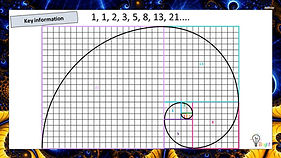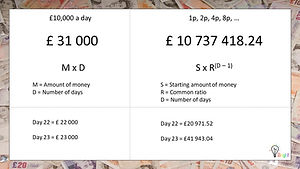Enrichment
A variety of activities, lessons and projects to extend students love of mathematics beyond the curriculum
Numeracy time resource
174 different activities suitable for numeracy lessons during registration period.
The PowerPoint contains a challenge for each week, sorted into year groups and half terms for your convenience.
Some activities are open ended and without solutions. For those that have an answer, they are now provided!
There are accompanying printouts for some activities which may be needed in order for students to access the problem.



When to use:
One per week from years 7 to 11!
Binary
Teach students why we call our place value system the decimal number system, or base10.
Students will learn about a practice using the binary number system.
There are AFL questions, a match up task and a challenge activity.



When to use:
Year 7 Unit 1
Castles
Students add two adjacent bricks to find the value of the brick on the top of them.
Using the numbers 1 to 5, which of the castles 50-59 is impossible?
What is the smallest castle you can make? What is the largest?
What do you notice about how the numbers on the bottom level are arranged?
Create as many different castle 20's as you can.


When to use:
Year 7 Unit 2
Design a bedroom project
Lesson 1 - Design a floor plan for your room
Draw to scale on either paper or on computer
Add in a window and door
Lesson 2 - Draw the walls to scale including the door and window
Lesson 3 - Calculate the area of your floor
Decide on a floor covering (carpet, laminate ...)
using the ORNO catalogue
Calculate the cost of your floor
Lesson 4 - Calculate the area of your walls
Decide on wallpaper/paint/mural for each wall
using the ORNO catalogue
Calculate the cost of the walls
Lesson 5 - Pick out your furniture using the ORNO catalogue
Keep track of your budget!
Lesson 6 - Pick out your decor using the ORNO catalogue
Keep track of your budget!




When to use:
Year 7 Unit 3 | Year 8 Unit 4 | Year 9 Unit 7
Fibonacci sequence
One off lesson on the famous Fibonacci sequence. Students will learn about how the sequence is formed, draw their own golden spiral and see examples of this spiral in nature. The are also introduced to the golden ratio.


When to use:
Year 7 Unit 7 | Year 9 Unit 10
Jumping frogs
The classic puzzle!
Students record the number of moves it takes to swap over the red and yellow frogs. They also record the number of slides and the number of jumps and find the nth term for these!
But this takes it a step further; what if the number of yellow and red frogs wasn't the same?


When to use:
Year 7 Unit 7 | Year 9 Unit 10
The Mayfield Project
Lesson 1 - Recall the data handling cycle
Formulate a hypothesis
Consider data collection methods
Lesson 2 - Use excel spreadsheet to review
the data and summarise
relevant data
Lesson 3 - Draw charts and diagrams to
represent your findings
Lesson 4 - Analysis the data using averages
and the range
Write a conclusion to your hypothesis
Lesson 5 - Optional extra lesson
Collect further data from your peers and compare those to the results of Mayfield school




When to use:
Year 7 Unit 11 | Year 8 Unit 13
Networking
One off lesson on Eulerian, Semi-Eulerian and Non-Eulerian graphs.
Students are introduced to the famous Seven Bridges of Königsberg problem.
They also have a real life application problem to solve at the end of the session.



When to use:
Year 8 Unit 5 | Year 9 Unit 8
Tessellation
Lesson on regular and semi regular tessellations.
How many are there and how do you know you have found them all?
There is also an opportunity for students to create their own tessellating pattern, taking inspirations from art!


When to use:
Year 8 Unit 11 | Year 10F Unit 6
Money management
Pick one of the four people to be your case study and calculate their net monthly income after income tax, national insurance, pension and student loan. Then explore the necessary and unnecessary monthly outgoings such as mortgage, car payments, diesel, food, childcare...


When to use:
Year 9 Unit 4
Cylindrical Soup
Which shape of container is the best to contain soup in?
What dimensions would be most favourable to minimise the surface area whilst obtaining the right volume?


When to use:
Year 9 Unit 8 | Year 10F Unit 5 | Year 10H Unit 9
The Pennies or the Pounds
Would you rather have £10,000 a day in for the next 31 days building up in your bank account or put 1p in the bank that turns into 2p the second day, then 4p, then 8p... etc for 31 days?
Ideal for part of a lesson on
geometric sequences.


When to use:
Year 9 Unit 10 | Year 10H Unit 2
Folding to the moon
"How many times would you need to fold a piece of paper to reach the moon?"
A one off investigation on folding paper until you reach the moon.


When to use:
Year 9 Unit 2 | Year 11F Unit 4
Pythagorean Shoe Laces
Students study three different ways to lace trainers and start with the question; which of these lace patterns would use the smallest length of lace?
What about when we vary the number of holes or the distance between the gaps?
A much more challenging question is to create a general formula for each design



When to use:
Year 9 Unit 7 | Year 11F Unit 5
The Fly vs. The Spider
An investigation using Pythagoras' Theorem (including some work in 3D) to calculate the shortest distance between a fly and a spider in a glass tank.


When to use:
Year 9 Unit 7 | Year 11F Unit 5 | Year 11H Unit 3
Grudgeball
A one off lesson ideal for the end of the year (or when you only have a partial class due to trips!)
Grudgeball is a competitive game where students win points that they have to steal from other teams.
This one uses maths puzzles.


When to use:
Anytime!